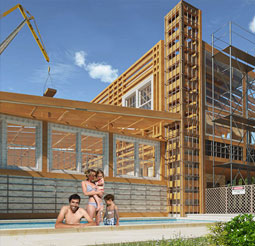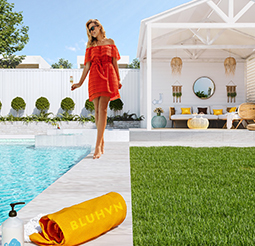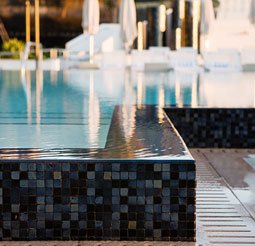Understanding Australian Pool Fence Legislations for Homeowners
July 1, 2024
If you own a swimming pool in Australia, you should be aware that there are strict regulations regarding pool fencing. These laws are designed to improve residential swimming pool safety and reduce the number of drowning incidents in Australia.
The Royal Life Saving Society of Australia reports that 29 deaths were recorded in swimming pools in 2022/2023. Less than 5 of these were attributed to public pools, meaning that residential and temporary accommodation pools account for the majority of these fatalities.
To further reduce Australian drowning incidents, installing pool fencing that complies with safety laws is essential.
Does each state have its own pool fencing laws?
There are very slight differences in pool fencing laws throughout Australia, however most regulations remain the same. You’ll find different entities involved and different methods for inspecting residential swimming pools. For example, a registered swimming pool inspector must check your fencing in NSW and Victoria. In the ACT, pools are checked by a licensed building surveyor.
The differences in pool fencing requirements by state are so minimal that for the purpose of this article, we’ll focus on the regulations that are standard across the country. The key message is to check requirements with your local council before installing a pool. Then, you’ll have all of the information and knowledge you need to comply with the laws.
Read on to find out more about swimming pool fencing regulations in Australia.
Pool registration
When installing a backyard swimming pool, you need to register it with the local council. The registration process will differ depending on where you live, so you should contact the council first. They can tell you exactly what’s required, but in most cases, it’s an easy online process.
We briefly touched on swimming pool inspections and the fact that each state handles this slightly differently. Bear in mind that as part of the council registration process, you’ll likely need to provide a certificate of compliance, and fencing is a big part of it. This is obtained by having your pool checked by the relevant authority, which could be a licensed pool inspector or a building surveyor.
When does a pool require fencing?
Most of Australia’s swimming pool fencing laws require a safety barrier around any body of water deeper than 30cm (300mm). It’s important to note that this typically applies to inflatable swimming pools and spas. If it can hold a depth of 30cm, then it requires a safety barrier.
Since this classification applies to almost every backyard swimming pool, you’ll need to know all of the safety barrier requirements. The laws are quite prescriptive about the height and other elements of your fencing, and we’ll go into more detail regarding this below.
Fencing height
The whole idea behind pool safety regulations is to keep people safe around the water. In particular, fencing ensures that small children can’t access swimming pools without supervision. As such, your fencing must comply with specific height standards.
Pool fencing must be at least 1.2m (1200mm) in height. You should also note that boundary fences and walls can also form part of your pool fencing, provided it meets all of the requirements. For example, a pool in the corner of your yard could potentially use two boundary fences. This would mean you only need to install two additional fence sides.
If you choose to use house walls as part of your pool fencing, you need to ensure the pool can’t be accessed from the home. For example, through a window or from a balcony.
The bottom of your pool fencing
In conjunction with ensuring your fencing is 1.2m high, you must also make sure the bottom is no more than 10cm (100mm) off the ground. This is obviously for safety reasons, but it’s a good design principle anyway. If you leave large gaps under your pool fence, the area becomes more accessible to local wildlife or even family pets. So, while protecting your family, you can also protect the animals.
We’ll touch on horizontal rails next, but keeping them close to the bottom and top of your fence is the best practice to make the fence harder to climb.
Horizontal rail regulations
There are two specific guidelines relating to the horizontal rails of your pool fencing. The idea behind these regulations is to ensure the fence can’t be easily climbed. As such, it’s usually good practice to limit the number of horizontal rails you use. One each near the bottom or top is usually standard, and this gives you more flexibility with your vertical post placement.
If your horizontal rails are less than 90cm (900mm) apart, the gaps between your vertical posts must be no more than 10mm wide. However, if there is a 90cm gap between your horizontal posts, the gaps between your verticals must be no more than 100mm wide.
Pool gate rules and regulations
Most pool safety fencing you buy these days includes a gate that complies with these regulations. So, you shouldn’t have to worry too much if you work with pool fencing experts. However, it’s worth knowing some of the guidelines because it doesn’t matter who installs your fencing. You’re the one responsible for ensuring it complies with government regulations.
Firstly, swimming pool gates must open away from the pool and you should never prop them open for convenience. Secondly, you must install a gate that self-closes from any position, and it must be self-latching.
Regarding the latch, it must be positioned so that small children can’t reach it. The guideline is for the latch to be at least 1.5m (1500mm) above the ground. Alternatively, the latch must be placed in the inside of the fence where it can’t be easily reached.
Around the fenced area
You must create a Non-Climbable Zone around all of your pool fencing. As we discussed, there are horizontal rail regulations to prevent the fence from being climbed, and these guidelines go a step further.
Basically, you must not have any climbable objects within 90cm (900mm) of the fence exterior. On the inside of your pool fence, climbable objects can’t be within 30cm (300m). This regulation exists to prevent people from using objects to climb the fence and access the pool.
Climbable objects can be anything from BBQs, outdoor furniture, large backyard items, and tree branches. Anything that a child could potentially climb must not be within reach of the pool fence.
Pool owners should note that this regulation applies to boundary fences and walls being used as pool fencing. So, if you’ve got neighbours, you’ll need their cooperation to apply the Non-Climbable Zone on their side of the fence.
Safety signage
While not directly related to fencing, pool owners are also required to have safety signage clearly displayed. Most important is a CPR sign, which must be readable from at least 3m away. It must be 30cm x 30cm in size at a minimum, and be visible from anywhere within the pool area.
Ideally, you should attach the CPR sign to your pool’s safety barrier. Ensure that the sign is made of high-quality materials so that it doesn’t fade or become damaged in the weather. If you need more information about CPR signs that meet pool safety regulations, ask the team at Blue Haven.
Doors and windows
While we already mentioned that you can use the wall of your house as part of your pool fencing, you must not have internal door access to the pool. This only applies if you intend to use your wall as part of the fence. You can still have a door going from inside the home to the outdoor area, but the pool must be separately fenced.
For indoor pools, all doors must open outward and be self-closing and self-latching. Basically, the door and its latch must be child-resistant. Regarding windows, unless they are more than 1.8m above the ground, they can’t open more than 10cm (100mm). Alternatively, they must have locks and screens.
What to do before selling or leasing your property
If you decide to sell your home or rent it out to somebody else, you’ll need to get a pool safety certificate. This gives buyers and renters peace of mind that your swimming pool meets all safety requirements and won’t become a liability. Nobody wants to move into a new house and be fined for breaching pool regulations.
The process for obtaining a pool safety certificate is different for each council, but typically, it requires a registered pool inspector. Once the pool has been checked and deemed to meet all safety requirements, you’ll be issued with a safety compliance certificate.
Need help planning your swimming pool installation?
Blue Haven specialises in designing and constructing beautiful residential swimming pools. With a range of options for inground, above-ground, fibreglass or concrete pools, customisation is our specialty. Bring us your ideas, and we’ll deliver the design and construction of your stunning new residential pool. For the eco-conscious, ask us about our amazing mineral pools today. Contact Blue Haven for all of your swimming pool needs. We can even provide advice on pool fencing regulations in your area.
Read More:













